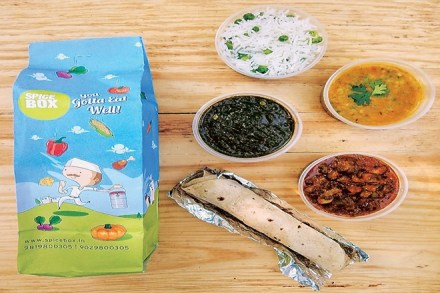The online food delivery business has transformed the way we eat and what we eat. From special fares for special occasions to the routine lunch fix — consumers are increasingly relying on food delivery services. As per RedSeer, the Indian online food delivery market is expected to reach $4 billion by 2020. And a small space within this universe is occupied by tiffin start-ups jostling against the biggies — food aggregators such as Zomato and Swiggy.
Finding the right model
SpiceBox is one such player in the online tiffin space that sees a y-o-y revenue growth rate of 45-50%. Currently only in Mumbai, the brand is looking to expand to Delhi, Pune and Bengaluru over the next three months. In a business model like this, operational costs take up a majority of the capital, as does the fluctuating cost of raw materials. Gurmeet Kochhar, founder, SpiceBox, has found a way out.“Centralised operations ensure our costs are under control. Furthermore, a way to beat food inflation is to build annual contracts so that we are not affected to a great extent by fluctuations,” he says. SpiceBox’s FY18 revenue was Rs 4.5-5 crore.
Also read| Ericsson attempting media trial to recover dues; jeopardising interest of secured lenders: Reliance Communications
However, not everyone is in favour of a rigid and long-term subscription format. Last January, FreshMenu launched its membership programme called FreshClub that offers its members exclusive dishes, discounted prices and a post-trial membership price of Rs 99 for three months. Rashmi Daga, FreshMenu’s founder and CEO , admits that while exclusive dishes are not “huge” for the brand right now, that space is used to hold food festivals and roll out limited time dishes aimed at encouraging new users to sign up.
The brand also has a corporate programme which, along with FreshClub, accounts for 30-40% of its sales. The intent of such programmes, Daga says, is to give people the convenience of ordering without glitches. “We will have kiosks or a cash-and-carry counter in a few offices or we could have the HR teams pre-booking their office orders with us,” she shares.
US-based MealPal seems to have found the middle ground to make the subscription model work. Present in the US, Canada, Australia, Singapore and the UK, MealPal puts customers on a subscription plan that allows them to order meals with one catch — the customer has to pick the meal up from the restaurant. However, this gives customers food at a cheaper price than they would otherwise get at the same restaurant, while also helping MealPal bypass the cost of food delivery.
Serving the next course
Rohan Agarwal, engagement manager, RedSeer, points out that tiffins as an online service has not picked up yet, which makes scaling up a difficult task. “Lunch and tiffins in general are what the aggregators will also vie for. Indirectly, the consumer segment is being catered to by flat-priced meals being offered by the aggregators,” he says. “It is not a binding subscription, but the habit is being built. Going forward, they can always start offering it as a service with plans like, ‘buy 30 meals for the price of 20’.”
To differentiate itself from other players, happyGrub has broadly classified its meals as healthy, Jain and diabetic. Based in Mumbai, it currently serves 500-550 orders per day and is looking to expand to Pune this year. Dhrumil Modi, director, happyGrub, observes that general subscribers offer more potential for growth compared to corporates that offer lesser margins.
The market for online food delivery services remains concentrated in the metros with over 80% of order volume coming from cities such as Mumbai, Delhi, Bengaluru and Pune. Expansion to other cities comes with its own challenges. For instance, when a SpiceBox looks to enter Bengaluru — a city that already has a host of meal subscription players — it cannot merely be an alternative to existing players. Catering to that market, Kochhar says, will involve making a few tweaks to the menu. “It has a big population of migrants from North Indian states who do not get the kind of food they are looking for,” he explains.
Even after the local cuisine problems have been addressed, the larger questions still remain. “It is a twofold challenge: one is serving tiffins in itself, and the second is being able to market yourself against the aggregators and be remembered as an option in the consumer’s mind,”
Agarwal points out.
